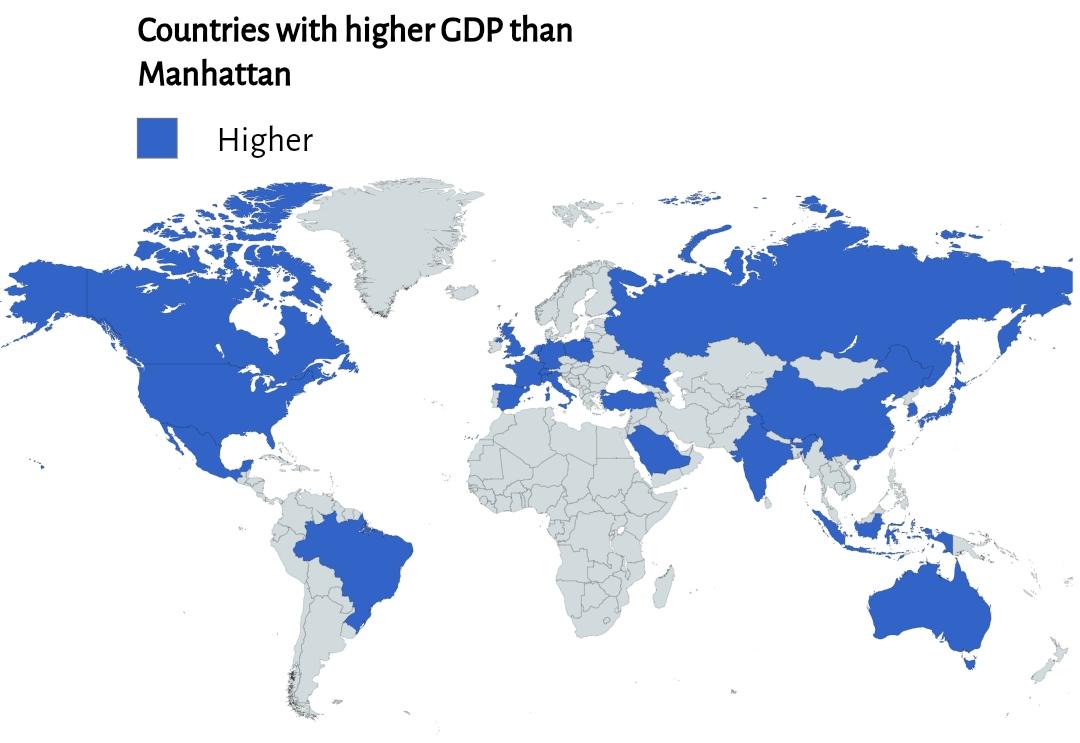GDP Comparison Map of Manhattan County


Alex Cartwright
Senior Cartographer & GIS Specialist
Alex Cartwright is a renowned cartographer and geographic information systems specialist with over 15 years of experience in spatial analysis and data...
Geographic Analysis
What This Map Shows
This map provides a striking visualization of the economic power of Manhattan County by comparing its Gross Domestic Product (GDP) to that of nations around the globe. Interestingly, only 21 countries boast a higher GDP than this bustling part of New York City, which is a testament to its economic vitality and significance. But what does this tell us about Manhattan itself and the broader implications for urban economic power?
Deep Dive into GDP and Economic Power
Gross Domestic Product, or GDP, is a critical indicator used to gauge the economic performance of a region. It represents the total dollar value of all goods and services produced over a specific time period within a jurisdiction. In the case of Manhattan, its GDP exemplifies not only the wealth generated from its diverse sectors, such as finance, media, and technology, but also its role as a global economic hub.
Manhattan's economy is one of the most dynamic in the world. As of recent data, its GDP is estimated to be over $600 billion, placing it among the top financial centers globally. This immense economic output is significantly driven by the financial services sector, which includes major banks, investment firms, and insurance companies. What's fascinating is that Wall Street, located in Lower Manhattan, is often referred to as the financial capital of the world, underscoring the area's influence on global finance.
Moreover, the technology and media industries are rapidly expanding in Manhattan, contributing to its GDP growth. With tech giants establishing their offices in the area, the demand for innovation and entrepreneurship has surged, creating a vibrant start-up culture. According to the NYC Economic Development Corporation, tech jobs in Manhattan have grown by over 25% in recent years, showcasing a shift in economic drivers away from traditional sectors.
However, the real estate market also plays a crucial role in Manhattan's GDP. The demand for commercial and residential properties has skyrocketed, leading to some of the highest rental prices in the world. This not only reflects the desirability of living and working in Manhattan but also contributes significantly to the local economy through property taxes and associated expenditures.
Regional Analysis
When analyzing the economic landscape represented in the map, it’s essential to consider the regional context. For instance, comparing Manhattan’s GDP with that of countries like Luxembourg or Singapore, which also rank high in GDP, can highlight the unique characteristics of urban economies versus national economies. Luxembourg, a small but wealthy nation, has a GDP driven primarily by financial services and investment, much like Manhattan. In contrast, Singapore's GDP benefits from its strategic position as a trade hub in Asia, showcasing different paths to economic success.
Furthermore, looking at regions within the United States, cities like San Francisco and Los Angeles also demonstrate substantial GDP figures, but they differ in their economic compositions. San Francisco, for instance, is heavily reliant on technology and biotech industries, while LA has a diverse economy that includes entertainment, manufacturing, and tourism. This comparison illustrates how urban centers can thrive economically yet maintain distinct characteristics based on their industries.
Significance and Impact
Understanding the economic stature of Manhattan in relation to countries around the world matters for several reasons. First, it emphasizes the importance of urban areas in the global economy. Cities like Manhattan are not only centers of commerce but also cultural and social hubs that attract talent and investment from around the globe. The concentration of industries and resources in such urban settings often leads to innovation and economic advancement, impacting wider trends in economic development.
Moreover, this economic prowess has implications for urban planning and policy-making. As cities continue to grow, the challenge will be to manage this growth sustainably while addressing issues like income inequality, housing affordability, and infrastructure development. The rapid economic changes in Manhattan serve as a case study for city planners and policymakers worldwide.
In conclusion, the map highlighting that only 21 countries have higher GDP than Manhattan County reveals much about the economic landscape of urban areas today. It invites us to consider the future of global cities and their role in shaping not just local, but international economies as well. What will the next decade bring for Manhattan, and how will it continue to adapt to the ever-changing economic environment? Only time will tell, but one thing is clear: Manhattan is not just a borough; it's an economic powerhouse that stands shoulder to shoulder with nations around the world.
Visualization Details
- Published
- September 28, 2025
- Views
- 72
Comments
Loading comments...